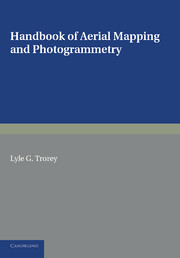Book contents
- Frontmatter
- Dedication
- FOREWORD
- PREFACE
- Contents
- LIST OF TABLES
- Bibliography
- Notation
- CHAPTER 1 PERSPECTIVE PRINCIPLES
- CHAPTER 2 MEASUREMENT OF ANGLES FROM OBLIQUES
- CHAPTER 3 PERSPECTIVE GRID AND FOUR-POINT METHODS
- CHAPTER 4 MEASUREMENT OF HEIGHT FROM A SINGLE OBLIQUE
- CHAPTER 5 VERTICALS: FUNDAMENTAL CONSIDERATIONS OF COVER, PARALLAX AND STEREOSCOPY
- CHAPTER 6 PARALLAX AND ELEVATION CALCULATIONS
- CHAPTER 7 RADIAL-LINE TRIANGULATIONS, GRAPHICAL AND MECHANICAL
- CHAPTER 8 RECTIFICATION MEANS
- CHAPTER 9 SUBDIVISIONS OF AN AIR SURVEY MAPPING OPERATION
- CHAPTER 10 PRINCIPLES OF STEREOSCOPIC PLOTTING INSTRUMENTS
- CHAPTER 11 THE MULTIPLEX PROJECTOR
- APPENDIX 1 STANDARD MAPPING PROCEDURE ROYAL CANADIAN ENGINEERS
- APPENDIX 2 MULTIPLEX AND STEREOPLANIGRAPH: CONSIDERATIONS GOVERNING MINIMUM CONTOUR INTERVAL
- APPENDIX 3 THE KELSH PLOTTER
- INDEX
CHAPTER 5 - VERTICALS: FUNDAMENTAL CONSIDERATIONS OF COVER, PARALLAX AND STEREOSCOPY
Published online by Cambridge University Press: 05 June 2016
- Frontmatter
- Dedication
- FOREWORD
- PREFACE
- Contents
- LIST OF TABLES
- Bibliography
- Notation
- CHAPTER 1 PERSPECTIVE PRINCIPLES
- CHAPTER 2 MEASUREMENT OF ANGLES FROM OBLIQUES
- CHAPTER 3 PERSPECTIVE GRID AND FOUR-POINT METHODS
- CHAPTER 4 MEASUREMENT OF HEIGHT FROM A SINGLE OBLIQUE
- CHAPTER 5 VERTICALS: FUNDAMENTAL CONSIDERATIONS OF COVER, PARALLAX AND STEREOSCOPY
- CHAPTER 6 PARALLAX AND ELEVATION CALCULATIONS
- CHAPTER 7 RADIAL-LINE TRIANGULATIONS, GRAPHICAL AND MECHANICAL
- CHAPTER 8 RECTIFICATION MEANS
- CHAPTER 9 SUBDIVISIONS OF AN AIR SURVEY MAPPING OPERATION
- CHAPTER 10 PRINCIPLES OF STEREOSCOPIC PLOTTING INSTRUMENTS
- CHAPTER 11 THE MULTIPLEX PROJECTOR
- APPENDIX 1 STANDARD MAPPING PROCEDURE ROYAL CANADIAN ENGINEERS
- APPENDIX 2 MULTIPLEX AND STEREOPLANIGRAPH: CONSIDERATIONS GOVERNING MINIMUM CONTOUR INTERVAL
- APPENDIX 3 THE KELSH PLOTTER
- INDEX
Summary
Verticals
Introduction. Certain of the methods described in preceding sections are often spoken of as being techniques of a single photograph. This is perhaps a misnomer (see the definition of p. i), since, in all cases involving mapping of an area larger than the extent of a single exposure, overlapping pairs are used. Both with non-verticals and with verticals interpretation should be done stereoscopically if advantage is to be taken of the full value of the photography.
Techniques using vertical photography are, similarly, often described as mapping from stereoscopic pairs. This term, too, is misleading. For while we measure parallax differences with the aid of a stereoscope, and sketch contours stereoscopically, still, all the simple mapping methods described in this and succeeding chapters accept shape, both of detail and of contour (sensibly) as shown upon a single overlap of the pair. Not until ‘automatic’ plotting machinery is employed do we actually map from stereoscopic pairs, obtaining the true orthogonal projection of the relief model.
Overlap. When it is required that an area be covered by vertical photographs, the aircraft flies as nearly as possible in a straight course at the constant height indicated by scale and other considerations. A strip of photographs is exposed in such a manner that each principal point appears on the preceding and on the following picture, and each thus contains three principal points, its own and that of each adjacent picture of the strip. The foregoing results in the necessity of a minimum fore-and-aft overlap of 50%. To allow for tilt and relief, for variations in height of aircraft above the ground, and for crab (q.v.), it is usual to specify 60% fore-and-aft overlap,and the exposure interval is adjusted accordingly.
Fig. 30 should make the arrangement clear. Note how the overlap decreases with the high ground at P1 and increases in the valley at P2. The whole area to be mapped is covered by a parallel series of such strips, and it is customary to specify that there be a lateral overlap of 20-35 %.
- Type
- Chapter
- Information
- Handbook of Aerial Mapping and Photogrammetry , pp. 56 - 70Publisher: Cambridge University PressPrint publication year: 2013



